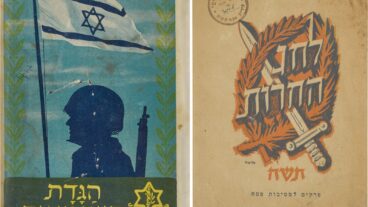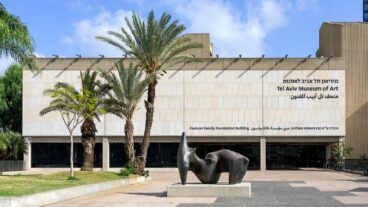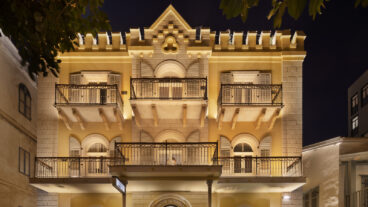Dr. Aren Maeir, Senior Lecturer at Bar Ilan University’s Institute of Archeology and Director of the Tell es-Safi/Gath Archaeological Project, and some of his volunteers.Indiana Jones would have never let travel bans and terror threats stand in the way of a good archeological dig. Especially if the field work was among some 35,000 known archaeological sites in Israel, ranging from small areas containing only loose pottery shards to large, fortified, walled cities like Masada and the City of David in Jerusalem.
That was the conclusion drawn by dozens of American volunteers, students and amateur archeology buffs who joined their Israeli counterparts and additional volunteers from Europe at eleven major excavations being conducted in Israel this summer.
By and large, security concerns and dwindling funding for large-scale digs have kept many American institutions and universities away, including hundreds of students and volunteers who are an essential part of any archeological project. A four-year old U.S. State Department travel advisory warning Americans against visiting Israel and the region has certainly not helped, resulting in some excavations being suspended in 2002 and 2003, amid the post-September 11 security concerns.
But this year, the wannabe discoverers are back with a vengeance – scattered throughout the country with trowel and pickaxe in hand in an attempt to make sense of the country’s rich layers of history hidden beneath the ground.
“After 9/11 it became almost impossible to come, people were hesitant because of the security situation and insurance companies weren’t willing to cover us,” said Dr. Ron Tappy, professor of bible and archaeology at the Pittsburgh Theological and director of excavations at Tell Zeitah (Tel Zayit in Hebrew), an ancient village believed to be biblical Libnah in ancient Judah (Joshua 10; 2 Kings 19:8).
“It’s good to be back again in the field,” Tappy said. “We had about 45 professional staff and volunteers this summer, but I could have used twice as many people. Hopefully we’ll see more come out and dig with us next year.”
Excavated for the first time in 1999, volunteers at Tell Zeitah have discovered a large Late Bronze Age public building or palace and have studied a significant destruction level from the ninth century BCE that is thought to be associated with an Aramean invasion. Other finds include artifacts that date from the mid-eighth century BCE, the time just prior to King Hezekiah, the prophet Isaiah, and the rise of Assyrian influence in the region.
“There is a lot of history to uncover here and volunteers are something that we sorely need to continue our work,” Tappy added.
Meanwhile, several miles away, another dig is attracting the kind of numbers Tappy has been dreaming about.
Located in the Ayalah Valley between the Judean foothills leading up to Jerusalem and the coastal plain, Tell es-Safi (Tel Tsafit in Hebrew) is identified by most scholars as the home of Goliath, of David and Goliath fame, and one of the five ancient Philistine cities that also includes Ashdod, Ashkelon, Ekron and Gaza. This link to the biblical past, together with the discovery of rich early Bronze Age remains, a ninth century BCE destruction level that corresponds with the conquests of Aramean King Hazael of Damascus (2 Kings 12:18), and a unique siege trench from the Iron Age, has attracted many the world over.
“For several years overseas volunteers were simply not coming,” said Dr. Aren Maeir, Senior Lecturer at Bar Ilan University’s Institute of Archeology and Director of the Tell es-Safi/Gath Archaeological Project, which has been excavating the biblical Philistine city of Gath since 1996. “But, this year the amount of volunteers and students on my dig jumped substantially to about 100 at one time compared with 30 a couple of years ago. It seems that the people who are interested in archeology have come to the realization that the [political] situation won’t change any time soon and they’re going to come anyway.”
This year’s dig includes a group of American students from Yeshiva University in New York and from the Hebrew Union College-Jewish Institute of Religion in Cincinnati, Ohio, as well as Israeli students from Bar Ilan University in Tel Aviv. In addition there are about 50 additional volunteers, mostly from the US, but some from Germany, Austria, Switzerland, and even Ukraine.
“The group is about as mixed as it gets and is working out nicely,” Maeir added. “We’re happy to see so many people interested in what we’re doing here, especially a small core group of volunteers who come back every summer as part of their vacation. It’s always a pleasure to have volunteers like this because they understand what’s going on and excavate perfectly.”
Settled almost continuously from the Chalcolithic period (fifth century BCE) until the 1940s, Tell es-Safi is one of the largest and most important pre-classical archeologist sites in Israel, occupying some 400-500 dunams (about 100 acres). With so much to uncover, students and volunteers remain an integral part of the excavation.
“It’s brutal hard work, but it’s fun and I’m learning a lot about the history and practical field work,” said Thomas Beyl, an Ancient Near East Studies graduate student from Hebrew Union College, who was busy clearing a grid site under grueling hot summer temperatures.
Trying to avoid working long hours in the sun, volunteers dig, shovel and haul baskets of earth from 6 a.m. to 1 p.m., with the rest of the day spent learning about various excavation processes, such as analyzing pottery shards, and attending lectures about the site and Israeli archaeology in general.
“If everything works out I hope to return next year with some of my HUC colleagues to manage a section,” Beyl added.
Also helping on site is Michael and Kathy Pincus of Boca Raton, Florida, who came to Israel to assist their daughter in ground-penetrating radar (GPR) work, a geophysical method that uses high frequency pulsed electromagnetic waves to acquire subsurface information. GPR is often used for oil and mineral exploration, but is also useful in locating buried objects.
“GPR can help archeologists make strategic decisions about where to start digging and where not to,” said Jessie Pincus, a PhD student of geology and archeology at the University of Miami, with plans on moving to Israel later this year to finish her degree at Bar Ilan University.
“Trying to bring technology towards archeology into the future, that’s what I’m about,” Pincus said. “The technology can be applied anywhere, but I love Israel and want to apply it here.”
Using GPR Jessie and her family are currently helping Tell es-Safi excavation director Aren Maeir and his staff find the continuation of a massive trench surrounding the site. The trench, believed by Maeir to be an Aramean method of siege at the time – as opposed to the Assyrians who didn’t believe in long drawn out sieges and tended to blitzkrieg an enemy city – measures five meters deep, four meters wide and is over two kilometers long.
“This is an astounding logistical operation and one of the most interesting features that we have here, there is no parallel to it,” said Maeir. “We will continue to excavate here to learn more about the period in which this trench was built.”
It is finds like this that many archeologists hope will get volunteers excited and make them want to come back again and again.












